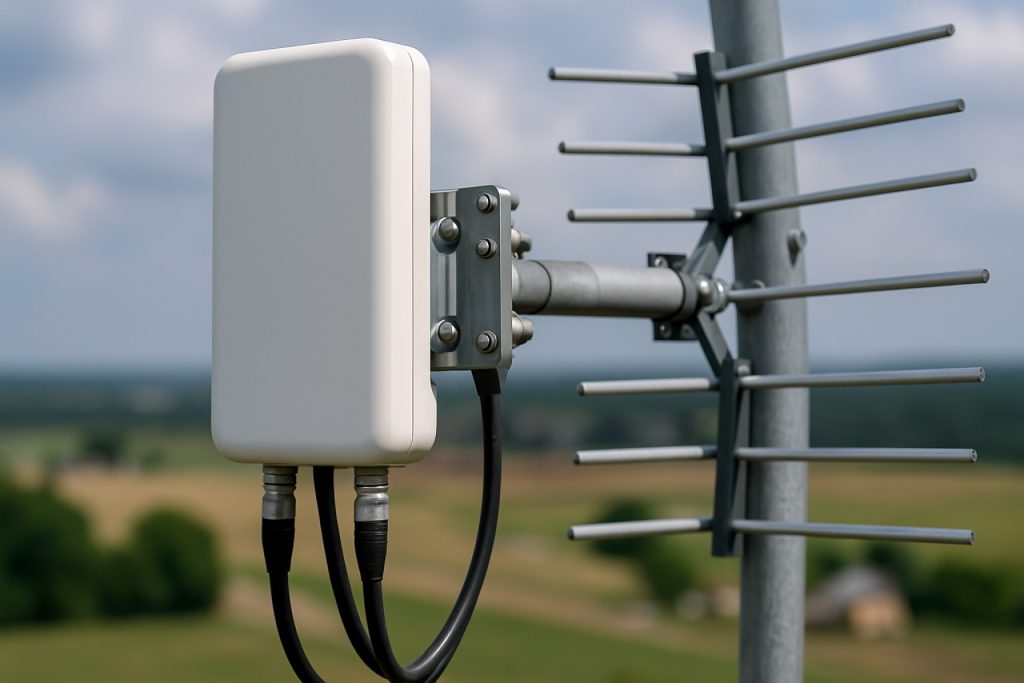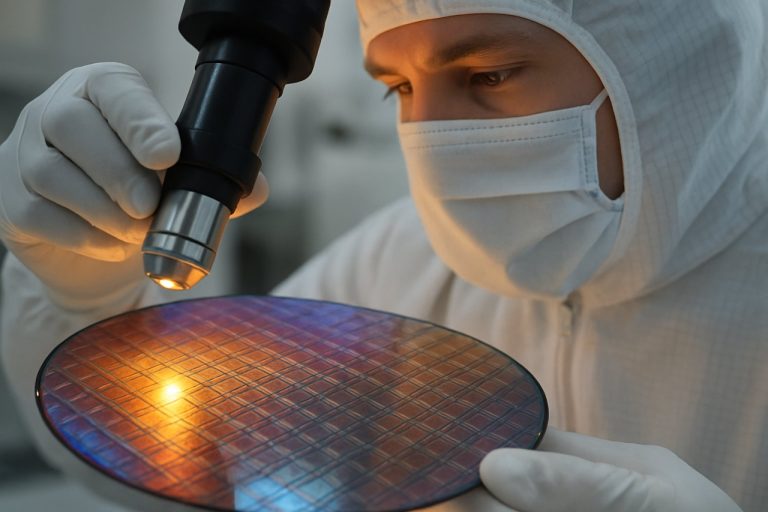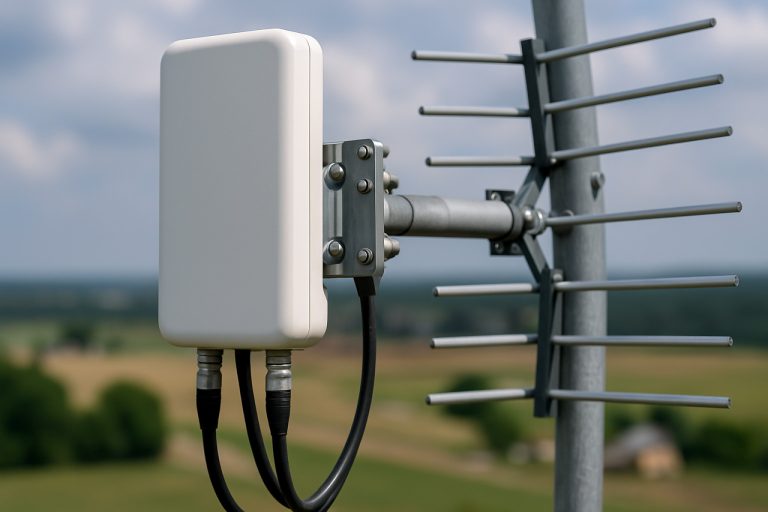
Unlocking the Power of TV White Space Hardware: How TVWS Devices Are Transforming Connectivity in Rural and Urban Landscapes. Discover the Technology, Market Trends, and Game-Changing Potential of TVWS Hardware.
- Introduction to TV White Space (TVWS) Hardware
- How TVWS Hardware Works: Technology Overview
- Key Components and Types of TVWS Devices
- Regulatory Landscape and Spectrum Availability
- Major Players and Innovators in TVWS Hardware
- Use Cases: Bridging the Digital Divide with TVWS
- Performance, Range, and Technical Challenges
- Market Trends and Future Outlook for TVWS Hardware
- Comparing TVWS Hardware to Other Wireless Solutions
- Deployment Success Stories and Case Studies
- Barriers to Adoption and Solutions
- Conclusion: The Road Ahead for TVWS Hardware
- Sources & References
Introduction to TV White Space (TVWS) Hardware
TV White Space (TVWS) hardware refers to the suite of devices and components designed to utilize the unused spectrum in the television broadcast bands for wireless communication. These frequency bands, often left vacant between active TV channels to prevent interference, are now being repurposed to deliver broadband connectivity, especially in underserved and rural areas. TVWS hardware plays a pivotal role in this transformation by enabling dynamic access to these frequencies while adhering to regulatory requirements.
A typical TVWS hardware ecosystem includes base stations, customer premise equipment (CPE), antennas, and spectrum sensing modules. Base stations act as central nodes, transmitting and receiving data over TVWS frequencies, while CPE devices connect end-users to the network. Advanced antennas and radio modules are engineered to operate efficiently across the wide range of TV broadcast frequencies (typically 470–698 MHz), offering robust signal penetration and extended coverage compared to traditional Wi-Fi or cellular bands.
One of the defining features of TVWS hardware is its integration with geolocation databases. These databases, mandated by regulators such as the Federal Communications Commission (FCC) and the Ofcom, inform devices of available channels in real time, ensuring non-interference with licensed TV broadcasters and other protected services. TVWS devices must also support dynamic frequency selection and power control to adapt to changing spectrum availability and regulatory constraints.
The development and deployment of TVWS hardware have been driven by collaborations among technology companies, research institutions, and regulatory bodies, resulting in a growing ecosystem of interoperable devices and solutions. This hardware is central to bridging the digital divide, enabling affordable and scalable broadband access in areas where traditional infrastructure is economically or logistically challenging.
How TVWS Hardware Works: Technology Overview
White Space Hardware, commonly referred to as TV White Space (TVWS) hardware, operates by leveraging unused spectrum in the VHF and UHF television broadcast bands. The core technology behind TVWS hardware involves dynamic spectrum access, where devices intelligently detect and utilize available frequencies without causing interference to licensed users, such as television broadcasters and wireless microphone operators. This is achieved through a combination of spectrum sensing, geolocation capabilities, and real-time access to regulatory databases.
A typical TVWS hardware setup includes a radio transceiver, a geolocation module (often GPS), and a network interface. The device first determines its precise location and then queries a cloud-based TVWS database, such as those managed by the Federal Communications Commission (FCC) or Ofcom, to obtain a list of available channels at that location. The hardware then configures its radio to operate only on the permitted frequencies, adjusting power levels and other parameters as required by local regulations.
TVWS hardware typically supports non-line-of-sight (NLOS) communication, making it well-suited for rural broadband, IoT backhaul, and smart city applications. The technology employs advanced modulation schemes and error correction to maintain robust connectivity over long distances and through obstacles. Additionally, many TVWS devices are designed to be software-defined, allowing for remote updates and adaptability to evolving spectrum policies and standards. This flexibility and intelligent spectrum management are key to the efficient and interference-free operation of TVWS networks Microsoft Research.
Key Components and Types of TVWS Devices
White Space Hardware, or TV White Space (TVWS) hardware, comprises a range of devices designed to utilize unused spectrum in the VHF and UHF television bands for wireless communication. The key components of TVWS hardware include base stations, customer premise equipment (CPE), antennas, and spectrum sensing modules. Each plays a distinct role in enabling dynamic spectrum access and reliable connectivity.
- Base Stations: These are central nodes that manage communication within a TVWS network, often equipped with advanced radios capable of frequency agility and dynamic power control. They connect to the internet backbone and coordinate spectrum use among multiple users.
- Customer Premise Equipment (CPE): CPE devices are installed at end-user locations to receive and transmit data over TVWS frequencies. They typically include integrated antennas and are designed for easy deployment in rural or underserved areas.
- Antennas: TVWS systems use specialized antennas optimized for VHF/UHF bands, supporting both omnidirectional and directional configurations to maximize coverage and signal quality.
- Spectrum Sensing Modules: These modules enable devices to detect available white space channels in real time, ensuring non-interference with licensed TV broadcasts. Many TVWS devices also integrate with geolocation databases to verify channel availability, as mandated by regulatory bodies such as the Federal Communications Commission (FCC).
TVWS hardware is available in various form factors, including fixed outdoor units for broadband backhaul, portable hotspots, and integrated IoT gateways. The diversity of device types and their modular architecture allow for flexible deployment in applications ranging from rural broadband to smart agriculture and public safety networks, as highlighted by organizations like the Microsoft Airband Initiative.
Regulatory Landscape and Spectrum Availability
The regulatory landscape for White Space Hardware (TVWS Hardware) is a critical factor influencing both the design and deployment of these devices. TV White Spaces refer to unused spectrum in the VHF and UHF television broadcast bands, which can be repurposed for wireless communication. However, the availability and use of these frequencies are tightly regulated to prevent interference with licensed broadcasters and other incumbent users. Regulatory bodies such as the Federal Communications Commission (FCC) in the United States and Ofcom in the United Kingdom have established frameworks that define how TVWS hardware can access spectrum, including requirements for dynamic spectrum access, geolocation capabilities, and database-driven spectrum management.
TVWS hardware must comply with these regulations by incorporating features such as spectrum sensing, GPS-based geolocation, and the ability to query certified databases to determine available channels in real time. The regulatory environment varies significantly by country, affecting the technical specifications and market potential for TVWS devices. For example, the FCC mandates that all TVWS devices in the U.S. must check a database every 24 hours to ensure they are not interfering with licensed users, while other regions may have different requirements or may not permit TVWS use at all. This patchwork of regulations impacts the global scalability of TVWS hardware and necessitates region-specific adaptations by manufacturers. Ongoing regulatory developments, such as the expansion of permissible power levels or the opening of additional spectrum bands, continue to shape the opportunities and challenges for TVWS hardware deployment worldwide International Telecommunication Union (ITU).
Major Players and Innovators in TVWS Hardware
The development and deployment of White Space Hardware (TVWS Hardware) have been driven by a mix of established technology companies and innovative startups, each contributing unique solutions to the ecosystem. Among the major players, Microsoft stands out with its Airband Initiative, which leverages TVWS technology to deliver broadband connectivity to underserved rural areas globally. Microsoft’s partnerships with local ISPs and hardware manufacturers have accelerated the adoption of TVWS devices, particularly in Africa, Asia, and the Americas.
Another significant contributor is Adaptrum, a Silicon Valley-based company specializing in TVWS radios and base stations. Adaptrum’s hardware solutions are known for their robust performance in challenging environments, making them a preferred choice for rural broadband projects. Similarly, 6Harmonics has developed a range of TVWS base stations and customer premises equipment (CPE) that support dynamic spectrum access and long-range connectivity, with deployments in North America, Africa, and Asia.
In the UK, Nominet has played a pivotal role by providing spectrum management databases and collaborating with hardware vendors to ensure regulatory compliance and efficient spectrum use. Meanwhile, RADWIN and iconectiv have contributed to the ecosystem by integrating TVWS technology into their wireless broadband portfolios and spectrum management platforms, respectively.
These innovators are not only advancing the technical capabilities of TVWS hardware but are also shaping regulatory frameworks and business models, ensuring that TVWS technology remains a viable and scalable solution for bridging the digital divide worldwide.
Use Cases: Bridging the Digital Divide with TVWS
White Space Hardware (TVWS Hardware) has emerged as a transformative solution for bridging the digital divide, particularly in rural and underserved regions where traditional broadband infrastructure is economically or logistically unfeasible. By leveraging unused spectrum in the TV broadcast bands, TVWS hardware—comprising base stations, customer premises equipment (CPE), and spectrum sensing devices—enables long-range, non-line-of-sight wireless connectivity. This capability is especially valuable for connecting remote schools, healthcare centers, and communities to the internet, fostering social and economic development.
One prominent use case is rural broadband deployment. Projects in countries such as Kenya, the United States, and the United Kingdom have demonstrated that TVWS hardware can deliver reliable internet access over distances exceeding 10 kilometers, even in challenging terrain. For example, the Microsoft Airband Initiative has partnered with local ISPs and governments to deploy TVWS networks, providing affordable connectivity to millions who previously lacked access.
Another significant application is in education. TVWS hardware has enabled remote schools to access digital learning resources, bridging educational gaps. In healthcare, TVWS-powered networks support telemedicine and remote diagnostics, improving outcomes in isolated areas. Additionally, TVWS is used for agricultural IoT, enabling smart farming through sensor networks that monitor crops and livestock.
These use cases highlight the versatility and impact of TVWS hardware in addressing connectivity challenges. As regulatory frameworks mature and hardware costs decrease, the role of TVWS in bridging the digital divide is expected to expand, supported by organizations such as the Federal Communications Commission (FCC) and the International Telecommunication Union (ITU).
Performance, Range, and Technical Challenges
White Space Hardware (TVWS Hardware) leverages unused spectrum in the TV broadcast bands to deliver wireless connectivity, often in rural or underserved areas. The performance and range of TVWS hardware are influenced by several technical factors. TVWS signals, operating in the VHF and UHF bands, can travel longer distances and penetrate obstacles better than higher-frequency Wi-Fi or cellular signals. Typical TVWS devices can achieve ranges of 10-20 kilometers in open environments, with data rates varying from a few Mbps up to 30 Mbps, depending on channel bandwidth, modulation, and environmental conditions Microsoft Airband Initiative.
However, TVWS hardware faces significant technical challenges. One major issue is dynamic spectrum access: devices must reliably detect incumbent users (such as TV broadcasters and wireless microphones) and avoid interference, often by querying a geolocation database in real time Federal Communications Commission (FCC). This requires robust spectrum sensing and database connectivity, which can be difficult in remote areas. Additionally, the available spectrum and allowed transmit power vary by region, affecting both range and throughput.
Hardware complexity is another challenge. TVWS radios must support wide frequency agility, advanced filtering, and dynamic power control, increasing cost and design complexity compared to conventional Wi-Fi or LTE equipment. Antenna design is also critical, as lower frequencies require larger antennas for optimal performance. Finally, regulatory compliance and certification processes can slow deployment and increase costs International Telecommunication Union (ITU).
Market Trends and Future Outlook for TVWS Hardware
The market for White Space Hardware (TVWS Hardware) is experiencing significant growth, driven by the increasing demand for affordable and wide-area wireless connectivity, especially in underserved rural and remote regions. TVWS technology leverages unused spectrum in the VHF and UHF television bands, enabling long-range, non-line-of-sight communication that is well-suited for broadband internet, IoT, and smart city applications. Recent years have seen a surge in pilot projects and commercial deployments across Africa, Asia, and parts of North America, with governments and regulatory bodies such as the Federal Communications Commission (FCC) and Ofcom supporting spectrum access frameworks and device certification processes.
Key market trends include the miniaturization and cost reduction of TVWS base stations and customer premises equipment, as well as the integration of advanced spectrum sensing and dynamic frequency selection technologies. Major hardware vendors are focusing on interoperability and compliance with evolving standards, such as those set by the IEEE (notably IEEE 802.22 and 802.11af). The adoption of cloud-based spectrum management databases is also facilitating more efficient and scalable deployments.
Looking ahead, the TVWS hardware market is expected to expand further as spectrum regulations become more harmonized globally and as the technology matures. Analysts project robust growth, particularly in emerging markets where traditional broadband infrastructure is lacking. However, challenges remain, including the need for greater regulatory clarity, improved device certification processes, and continued investment in R&D. Overall, TVWS hardware is poised to play a pivotal role in bridging the digital divide and enabling next-generation wireless services worldwide GSMA.
Comparing TVWS Hardware to Other Wireless Solutions
When comparing TV White Space (TVWS) hardware to other wireless solutions such as Wi-Fi, LTE, and traditional fixed wireless systems, several key distinctions emerge. TVWS hardware leverages unused spectrum in the VHF and UHF television bands, which typically offer superior propagation characteristics—enabling signals to travel longer distances and penetrate obstacles like walls and foliage more effectively than higher-frequency technologies such as Wi-Fi (2.4 GHz/5 GHz) or LTE (700 MHz and above). This makes TVWS particularly advantageous for rural broadband deployments and challenging terrains where line-of-sight is not always possible.
In terms of hardware, TVWS devices often include dynamic spectrum access radios, geolocation capabilities, and integration with spectrum databases to avoid interference with licensed TV broadcasters. This contrasts with Wi-Fi hardware, which operates in unlicensed bands and does not require spectrum sensing or database coordination. LTE and 5G solutions, while offering higher throughput and lower latency, generally require licensed spectrum and more expensive infrastructure, making them less accessible for low-cost, wide-area rural connectivity.
Another consideration is regulatory compliance. TVWS hardware must adhere to strict rules set by national regulators, including power limits and mandatory database checks, which can increase complexity and cost compared to plug-and-play Wi-Fi solutions. However, the flexibility and range of TVWS hardware can offset these challenges, especially in underserved areas. For example, pilot projects by Federal Communications Commission (FCC) and Ofcom have demonstrated the viability of TVWS for bridging the digital divide.
Ultimately, while TVWS hardware may not match the raw speed of urban LTE or 5G, its unique propagation and deployment advantages make it a compelling alternative for specific use cases where traditional wireless solutions fall short.
Deployment Success Stories and Case Studies
Deployment of White Space Hardware (TVWS Hardware) has demonstrated significant success in bridging the digital divide, particularly in rural and underserved regions. One notable case is the deployment in rural Kenya, where TVWS technology was used to provide broadband connectivity to schools and communities lacking traditional infrastructure. The project, led by Microsoft Airband Initiative, utilized TVWS radios and base stations to deliver affordable internet, resulting in improved educational outcomes and local economic development.
In the United Kingdom, the Broadband Delivery UK (BDUK) program piloted TVWS hardware in remote areas of Scotland and Wales. The initiative demonstrated that TVWS could reliably deliver broadband speeds sufficient for modern applications, even in challenging terrains where fiber deployment was cost-prohibitive. The project’s success led to further regulatory support and commercial interest in TVWS solutions.
Another compelling example is the deployment in the Philippines by Rice University in partnership with local ISPs. Here, TVWS hardware enabled connectivity across multiple islands, overcoming geographical barriers and frequent natural disasters that disrupt traditional networks. The project highlighted the resilience and scalability of TVWS hardware in disaster-prone regions.
These case studies underscore the adaptability and impact of TVWS hardware in diverse environments. They also illustrate the importance of collaboration between technology providers, governments, and local communities to ensure sustainable and scalable deployments of white space solutions.
Barriers to Adoption and Solutions
Despite the promise of TV White Space (TVWS) hardware in expanding broadband access, several barriers hinder its widespread adoption. One significant challenge is the high initial cost of TVWS devices, which often require specialized radios and antennas to operate efficiently in the fragmented and variable spectrum available. These costs can be prohibitive for small Internet Service Providers (ISPs) and rural communities, limiting deployment in the very areas that could benefit most from the technology. Additionally, the lack of standardized hardware and interoperability issues between devices from different manufacturers further complicate large-scale rollouts International Telecommunication Union.
Regulatory uncertainty also poses a barrier, as TVWS hardware must comply with dynamic spectrum access rules and database-driven spectrum management, which can vary significantly between countries and even regions. This regulatory complexity can deter investment and slow innovation Federal Communications Commission. Furthermore, the limited availability of certified TVWS equipment and the need for ongoing firmware and software updates to adapt to evolving spectrum databases add operational burdens for network operators.
To address these challenges, industry stakeholders are working towards developing open standards and certification programs to ensure interoperability and drive down costs through economies of scale. Regulatory bodies are also collaborating internationally to harmonize spectrum policies and streamline device certification processes. Additionally, public-private partnerships and targeted subsidies are being explored to offset initial deployment costs and encourage investment in underserved areas Microsoft Airband Initiative. These combined efforts aim to lower barriers and accelerate the adoption of TVWS hardware for bridging the digital divide.
Conclusion: The Road Ahead for TVWS Hardware
The future of White Space Hardware (TVWS Hardware) is poised for significant growth as global demand for affordable, wide-area wireless connectivity intensifies. TVWS technology, leveraging unused spectrum in the VHF and UHF television bands, has already demonstrated its potential to bridge the digital divide, particularly in rural and underserved regions. However, the road ahead will require continued innovation in hardware design, spectrum management, and regulatory frameworks.
Key advancements are expected in the miniaturization and energy efficiency of TVWS devices, enabling easier deployment and lower operational costs. Integration with emerging technologies such as 5G, IoT, and edge computing will further expand the use cases for TVWS hardware, from smart agriculture to disaster recovery communications. Interoperability and standardization efforts, led by organizations like the International Telecommunication Union (ITU) and the Institute of Electrical and Electronics Engineers (IEEE), will be crucial in ensuring seamless operation across diverse geographies and regulatory environments.
Despite these opportunities, challenges remain. Regulatory uncertainty, spectrum sharing complexities, and the need for robust security protocols must be addressed to unlock the full potential of TVWS hardware. Collaboration among governments, industry stakeholders, and research institutions will be essential to overcome these barriers and foster sustainable growth.
In conclusion, the evolution of TVWS hardware represents a promising pathway toward universal connectivity. With strategic investment and coordinated policy support, TVWS technology can play a transformative role in the global communications landscape, delivering high-impact solutions for both developed and developing regions.
Sources & References
- Ofcom
- Microsoft Research
- International Telecommunication Union (ITU)
- Adaptrum
- Nominet
- RADWIN
- IEEE
- Broadband Delivery UK (BDUK)
- Rice University



